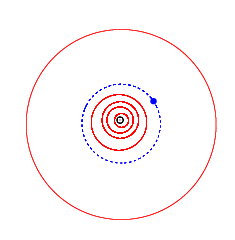9998 ISO
Appearance
 Orbit of 9998 ISO (blue), planets (red) [outermost shown is Jupiter], and the Sun (black). | |||||||||||||
| Discovery[1] | |||||||||||||
|---|---|---|---|---|---|---|---|---|---|---|---|---|---|
| Discovered by | C. J. van Houten, I. van Houten-Groeneveld, and T. Gehrels | ||||||||||||
| Discovery date | 25 March 1971 | ||||||||||||
| Designations | |||||||||||||
Named after | Infrared Space Observatory[2] | ||||||||||||
| 1293 T-1, 1991 PW15 | |||||||||||||
| Orbital characteristics[3] | |||||||||||||
| Epoch 13 January 2016 (JD 2457400.5) | |||||||||||||
| Uncertainty parameter 0 | |||||||||||||
| Observation arc | 22490 days (61.57 yr) | ||||||||||||
| Aphelion | 2.3654507 AU (353.86639 Gm) | ||||||||||||
| Perihelion | 1.9565241 AU (292.69184 Gm) | ||||||||||||
| 2.1609874 AU (323.27911 Gm) | |||||||||||||
| Eccentricity | 0.0946157 | ||||||||||||
| 3.18 yr (1160.3 d) | |||||||||||||
| 201.40965° | |||||||||||||
| 0° 18m 36.936s / day | |||||||||||||
| Inclination | 3.912471° | ||||||||||||
| 345.05820° | |||||||||||||
| 33.18077° | |||||||||||||
| Earth MOID | 0.957306 AU (143.2109 Gm) | ||||||||||||
| Jupiter MOID | 3.00049 AU (448.867 Gm) | ||||||||||||
| TJupiter | 3.688 | ||||||||||||
| Physical characteristics | |||||||||||||
| |||||||||||||
| 15.0 | |||||||||||||
9998 ISO is a main belt asteroid. It completes one solar orbit every 3.18 years.
Discovered on March 25, 1971 by C. J. van Houten & I. van Houten-Groeneveld on archival images taken by T. Gehrels, the body was given a provisional designation of 1293 T-1.[1][4] It was later renamed 9998 ISO to honour the Infrared Space Observatory.[2]
References
- ^ a b "Discovery Circumstances: Numbered Minor Planets (5001)-(10000)". Minor Planet Center. Retrieved November 6, 2013.
- ^ a b "Citation for (9998)". MPC 41571. Retrieved November 6, 2013.
- ^ "9998 ISO (1293 T-1)". JPL Small-Body Database. NASA/Jet Propulsion Laboratory. Retrieved April 13, 2016.
- ^ "9998 ISO (1293 T-1)". JPL Small-Body Database Browser.
External links
- 9998 ISO at the JPL Small-Body Database
Categories:
- Minor planet object articles (numbered)
- Main-belt asteroids
- Numbered minor planets
- Astronomical objects discovered in 1971
- Discoveries by Cornelis Johannes van Houten
- Discoveries by Ingrid van Houten-Groeneveld
- Discoveries by the Palomar–Leiden Trojan-1 survey
- Discoveries by Tom Gehrels
- Named minor planets
- Main-belt-asteroid stubs
